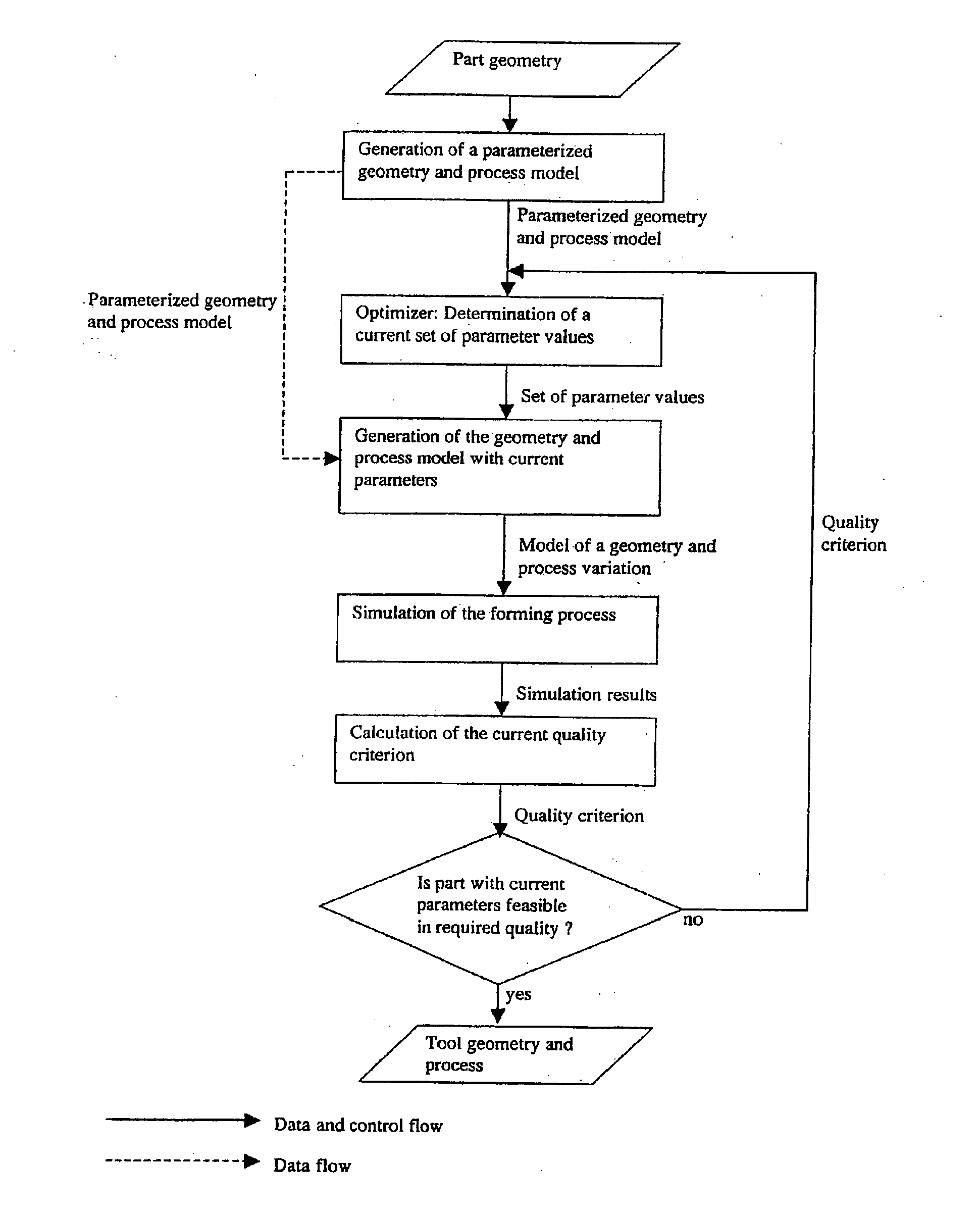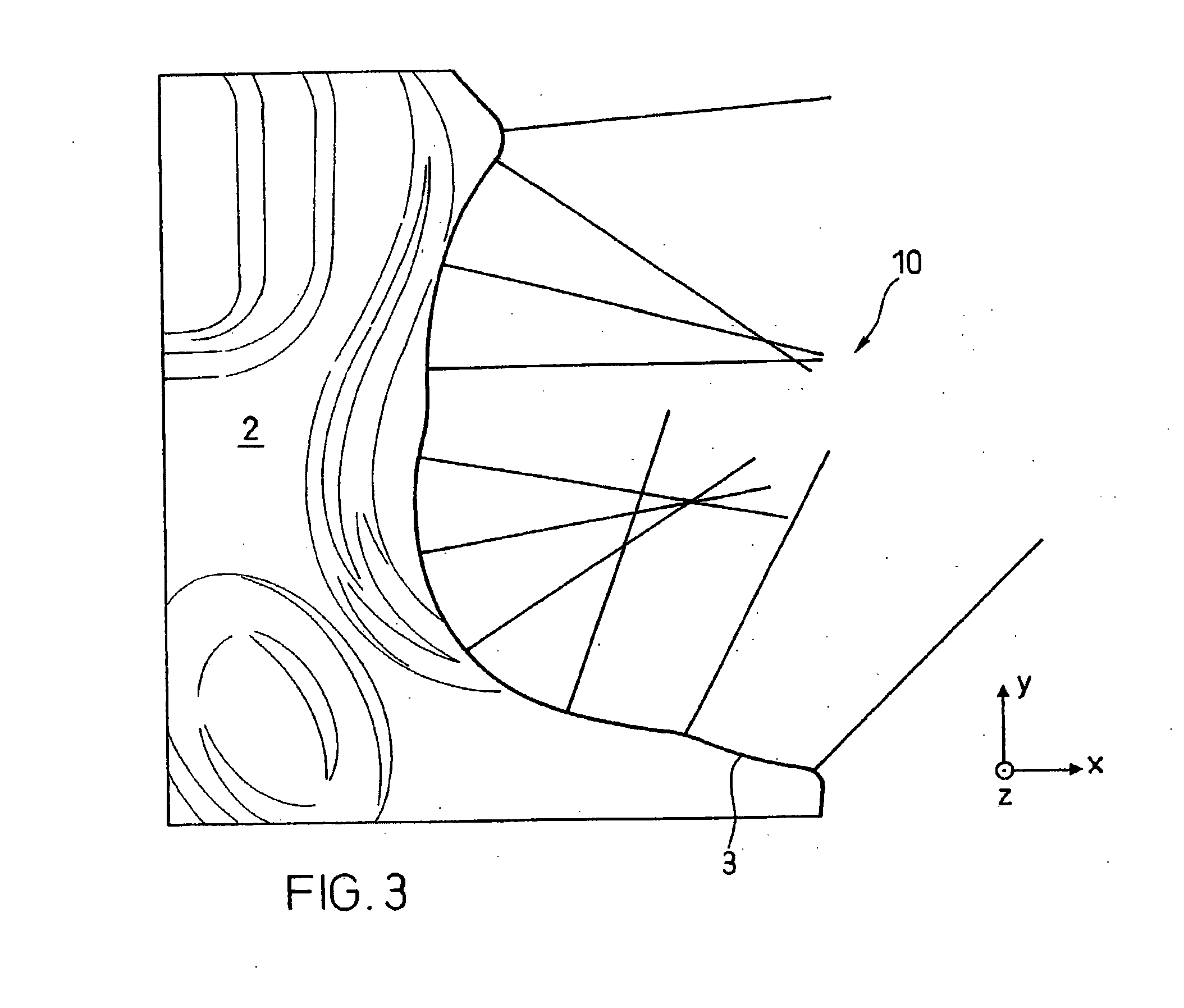[0009]It is an objective of the present invention to demonstrate a method how addendum surfaces for forming tools can be optimized and created efficiently and easily while avoiding the disadvantages known from prior art.
[0016]In the present invention, the initial directions of the sectional profiles on the edge of a component are preferably determined such that they point in the direction of the minimum geometrical change in a defined, fictitious edge zone of the component or in correlation with the flow-direction of the material. Alternative arrangements, such as in concave areas, are possible to avoid negative overlapping. The fictitious edge zone of the component is here notionally formed by a fictitious strip along the edge of the component (resp., the base line), lying in the inside of the component. This edge zone as a rule has a width, which is, for example, approximately 10-times the thickness of the sheet metal. How the direction of the minimum geometry change can be determined is illustrated in FIG. 5. If necessary, adjustments of the initial directions are possible to avoid disadvantageous overlapping of sectional profiles in concave areas.
[0019]The problem field described above is solved preferably as follows in the case of the invention divulged here: The sectional profiles are preferably described by a single type of geometry, (see FIG. 9), which has to be sufficiently general in nature to be able to describe the common sectional profile forms. Sectional profiles arranged next to each other are of corresponding nature making sure that no interpolation errors occur. These sectional profiles are parameterized by forming technology scalar values easy to comprehend by the user (hereinafter referred to as profile parameters), such as, for example, component run-off length, flange length, flange angle, draw bar height, draw bar width, draw bar radius, step height, wall angle, die radius, etc. The sectional profile is then built up based on these profile parameters out of basic elements, for example, circular arcs and line segments, in an automated manner (in this context refer to FIG. 9). In the case of inconsistent profile parameters, these are automatically adapted and optimized in accordance with a defined priority. In this manner, a sectional profile can be predefined exceedingly easily and clearly.
[0022]In the case of the invention divulged here, this problem is solved as follows. Sectional profiles possess characteristic points, which describe the principal course of the sectional profile, Mentioned as examples for such characteristic points shall be a summit of a draw bar, the flank of a step or the control points of a spline, of a Bèzier- or of a NURBS curve. Those characteristic points of every sectional profile corresponding to one another can now be joined together and with this form (continuous) characteristic lines, which extend along an addendum (parallel to a component edge) or at least over sections of it, e.g., the summit line of a draw bar (refer to FIG. 7). The lines defined in this manner are especially suitable for changing the addendum interactively, in that they, for example, are approximated as splines easily variable through control points. Both changes in a vertical direction (i.e., for example, the course of the height of a draw bar) as well as changes in horizontal direction (i.e., for example the horizontal position of the draw bar) can be implemented with this. The change specifically influences the corresponding parameters of the sectional profiles lying in the area of the change and correspondingly the addendum surface. Since a change of a characteristic line in a controlled manner influences several adjacent sectional profiles, such a change is significantly easier to implement than by means of the (manual) changing of individual sectional profiles. If the changing of a profile parameter is to lead to changes of other profile parameters in the adjacent sections (e.g., the changing of the draw bar height shall simultaneously cause a change of the width of the draw bar), then a corresponding working connection can be defined by a coupling matrix. In the case of the method described here, it is also possible to automatically smooth the characteristic lines. With this, geometry jumps at the edge of the component can be easily smoothed (in this context refer to FIG. 18). As smoothing algorithms, for example, one can again utilize uncoiling algorithms, and this both in the horizontal plane as well as in the height.
[0035]If desired, it is possible to use the geometrical information and data related to the tool (die, binder, punch) and the sheet metal part, handled and generated by the herein described invention, as input data for tooling. In this way it is possible to avoid additional processing by a CAD-System, which results in a further optimized process.
 Login to view more
Login to view more  Login to view more
Login to view more 


